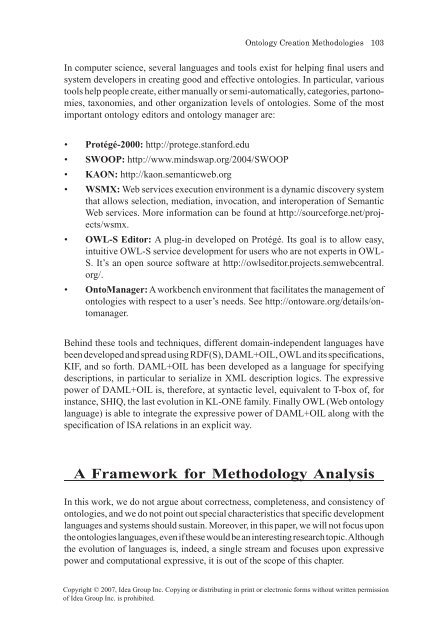Semantic Web-Based Information Systems: State-of-the-Art ...
Semantic Web-Based Information Systems: State-of-the-Art ...
Semantic Web-Based Information Systems: State-of-the-Art ...
Create successful ePaper yourself
Turn your PDF publications into a flip-book with our unique Google optimized e-Paper software.
Ontology Creat on Methodolog es 0<br />
In computer science, several languages and tools exist for helping final users and<br />
system developers in creating good and effective ontologies. In particular, various<br />
tools help people create, ei<strong>the</strong>r manually or semi-automatically, categories, partonomies,<br />
taxonomies, and o<strong>the</strong>r organization levels <strong>of</strong> ontologies. Some <strong>of</strong> <strong>the</strong> most<br />
important ontology editors and ontology manager are:<br />
• Protégé-2000: http://protege.stanford.edu<br />
• SWOOP: http://www.mindswap.org/2004/SWOOP<br />
• KAON: http://kaon.semanticweb.org<br />
• WSMX:.<strong>Web</strong> services execution environment is a dynamic discovery system<br />
that allows selection, mediation, invocation, and interoperation <strong>of</strong> <strong>Semantic</strong><br />
<strong>Web</strong> services. More information can be found at http://sourceforge.net/projects/wsmx.<br />
• OWL-S.Editor:.A plug-in developed on Protégé. Its goal is to allow easy,<br />
intuitive OWL-S service development for users who are not experts in OWL-<br />
S. It’s an open source s<strong>of</strong>tware at http://owlseditor.projects.semwebcentral.<br />
org/.<br />
• OntoManager: A workbench environment that facilitates <strong>the</strong> management <strong>of</strong><br />
ontologies with respect to a user’s needs. See http://ontoware.org/details/ontomanager.<br />
Behind <strong>the</strong>se tools and techniques, different domain-independent languages have<br />
been developed and spread using RDF(S), DAML+OIL, OWL and its specifications,<br />
KIF, and so forth. DAML+OIL has been developed as a language for specifying<br />
descriptions, in particular to serialize in XML description logics. The expressive<br />
power <strong>of</strong> DAML+OIL is, <strong>the</strong>refore, at syntactic level, equivalent to T-box <strong>of</strong>, for<br />
instance, SHIQ, <strong>the</strong> last evolution in KL-ONE family. Finally OWL (<strong>Web</strong> ontology<br />
language) is able to integrate <strong>the</strong> expressive power <strong>of</strong> DAML+OIL along with <strong>the</strong><br />
specification <strong>of</strong> ISA relations in an explicit way.<br />
A. Framework.for.Methodology.Analysis<br />
In this work, we do not argue about correctness, completeness, and consistency <strong>of</strong><br />
ontologies, and we do not point out special characteristics that specific development<br />
languages and systems should sustain. Moreover, in this paper, we will not focus upon<br />
<strong>the</strong> ontologies languages, even if <strong>the</strong>se would be an interesting research topic. Although<br />
<strong>the</strong> evolution <strong>of</strong> languages is, indeed, a single stream and focuses upon expressive<br />
power and computational expressive, it is out <strong>of</strong> <strong>the</strong> scope <strong>of</strong> this chapter.<br />
Copyright © 2007, Idea Group Inc. Copying or distributing in print or electronic forms without written permission<br />
<strong>of</strong> Idea Group Inc. is prohibited.


